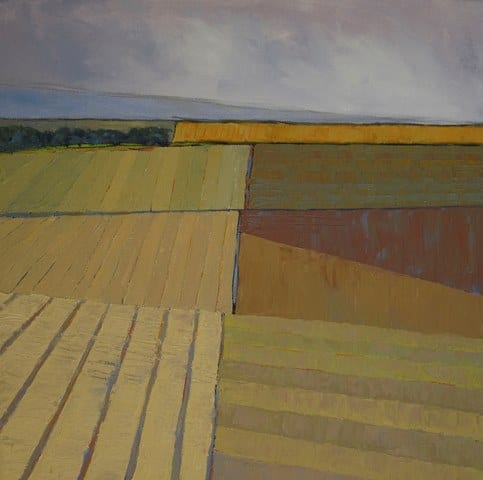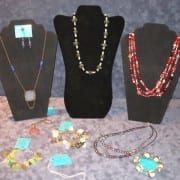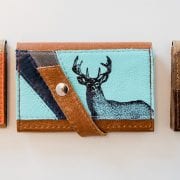The Unexpectedly Unconventional Square — Showcasing the Landscape Art of Gordy Edberg
In the mid twentieth century, the term “square” was derogatively used to connote a boring traditionalist, one reluctant to take chances or break out of the box in his or her thinking.
For 21st century artist Gordy Edberg, however, square is the new unusual, and the landscapes which he paints in this format are not constrained by what he calls the typical, conventional horizontal format that people have come to expect.
“The square format, with its harmony of shape, is a useful and non-natural approach,” the Whidbey Island artist says.
“By using the square structure, the landscape subject is contained more, and it removes the expected topographical connotations.
“Thus there are segments . . . fragments . . . sections of the landscape and their abstract qualities which are allowed to come forward.”
Edberg, who has been painting since high school 60 years ago, approaches his artwork from the perspective of an architect, a profession he made his central career for 41 years. The combination of the two disciplines results in Edberg’s signature style, one “grounded in realism with a leaning toward impressionism.”
With a principal focus upon the landscape, Edberg says that, although he does not purposely make political statements with his art, he is fascinated by the existing environment, and how it is changed by man’s impact upon it. There are buildings, roads, pathways, patterns, and how they integrate with their surroundings creates and shapes the finished piece. The very nature of lines themselves — an element strongly used in architectural drawing — invites the artist, and his viewers, to explore the realm of abstract within the world of reality.
“I look for change occurring, things disappearing, other characteristics of the environment that suggest potential for abstraction expressions,” Edberg explains. And herein that square format intensifies the fluidity of form and shape, emphasizing the transcendental in the midst of physical reality, bringing out the best of each.
“The goal is for the formal subject matter to be seen as a composition, an arrangement of shapes and colors and with aesthetic qualities while still suggesting place,” Edberg says.
While Edberg has painted landscapes from throughout the Pacific Northwest and the west coast, as well as forays into Hawaii, Mexico, Ireland, England, France, Italy, and Greece, it is his Southeastern Washington landscapes that showcase, boldly, the integration of line and form, abstract and reality, outline and shape. Large, illusorily monochromatic fields and agricultural spreads are intersected by roads, power lines, waterways and the patterns of the fields themselves, a balance of both natural and man-made factors.
Shots of unexpected color, calligraphy, textured paint, and marks and incisions upon the substrate surface enhance the mood and setting of the work, creating a place that is real and identifiable, yet not remotely as a camera would capture it.
“Landscape images and also urbanscape and marinescape images painted in the studio are many times imagined in response to the mood and feel of actual places that I’ve sketched or painted en plein air,” Edberg says. In the spirit of fluidity and freedom, he refers to plein air paintings or onsite sketches for his studio pieces, and does not rely upon the camera.
The goal is to catch the mood, the place, the feeling, because within each landscape, Edberg feels, there is a story, and it is his pleasurable goal to tell that story.
In addition to creating his oil-painted landscapes, Edberg also works in pastels, as well as designs and builds wood furniture. To do as much as he does requires space, and Edberg’s studio in the upper floor of his home is set up with four painting stations, including a wall easel which can accommodate up to six-foot sized paintings. The garage houses his woodworking equipment and tools, and, in addition to furniture making and packaging and shipping of paintings, another important activity takes place there: the cars can still be parked within.
That’s the architect, sharing space creatively with the artist.
A signature member with the Northwest Pastel Society, Edberg has earned awards from both that organization and the Puget Sound Group of Northwest Artists, and he has received Best of Show at the Washington State Convention Center Art Exhibition. His work is housed in both private and corporate collections throughout the U.S., and he maintains paintings in galleries on both the East and West coasts.
The architect may be retired, but the artist is very busy these days.
 Gordy Edberg is the featured artist at Wenaha Gallery’s Art Event from Monday, May 4 through Saturday, June 13, at Wenaha Gallery, 219 East Main Street, Dayton, WA.
Gordy Edberg is the featured artist at Wenaha Gallery’s Art Event from Monday, May 4 through Saturday, June 13, at Wenaha Gallery, 219 East Main Street, Dayton, WA.
Contact the gallery by phone at 800.755.2124 or e-mail art@wenaha.com. Gallery hours are 9 a.m. to 6 p.m. from Monday through Saturday, and by appointment. Visit the Wenaha Gallery website online at www.wenaha.com.
Wenaha Gallery is your destination location for Greenwich Workshop Fine Art Prints, professional customized framing, and original fine art paintings and sculpture by notable Pacific Northwest artists. Books, gifts, note cards, jigsaw puzzles, and more are also available. Visit at 219 East Main, Dayton, WA.
This article was written by Carolyn Henderson.
















